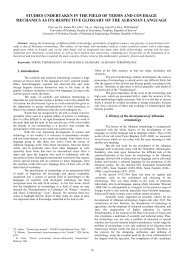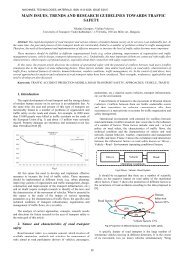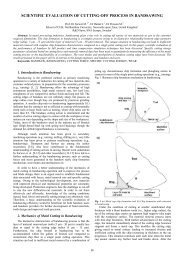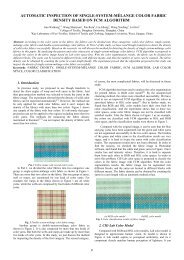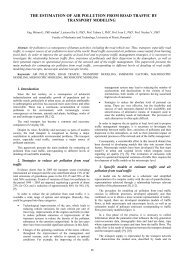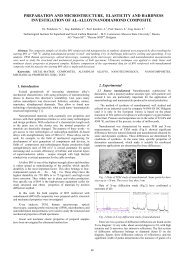Main characteristics for building automated ophthalmic complexes ...
Main characteristics for building automated ophthalmic complexes ...
Main characteristics for building automated ophthalmic complexes ...
Create successful ePaper yourself
Turn your PDF publications into a flip-book with our unique Google optimized e-Paper software.
MAIN CHARACTERISTICS FOR BUILDING AUTOMATED OPHTHALMIC<br />
COMPLEXES (AOC)<br />
Bojidar Madjarov<br />
Abstract: The requirements and the <strong>characteristics</strong> <strong>for</strong> <strong>building</strong> <strong>automated</strong> <strong>ophthalmic</strong> <strong>complexes</strong> (AOC ) are reviewed. Evaluation of the<br />
conditions and analysis of the technological order during the design and implementation of the <strong>automated</strong> <strong>ophthalmic</strong> <strong>complexes</strong> are<br />
per<strong>for</strong>med. Based on the analysis, instrumentation is proposed <strong>for</strong> the construction; including project <strong>characteristics</strong>, model criteria etc. The<br />
schematic diagram of the <strong>ophthalmic</strong> complex is presented.<br />
1. Automated <strong>ophthalmic</strong> complex as a conglomerate of <strong>automated</strong> components.<br />
1.1 Elements of the <strong>automated</strong> complex:<br />
AOC includes the following elements: (Fig. 1 and Fig. 2)<br />
Central component. This component serves as a connecting<br />
element to the peripheral components and it is an essential main<br />
element of the entire complex.<br />
Peripheral<br />
Module 1<br />
Peripheral components. These components are axillary. They can<br />
be a part of another <strong>automated</strong> complex and may work in non-real<br />
time.<br />
Peripheral<br />
Module 1<br />
Central Unit<br />
Peripheral<br />
Module 2<br />
Fig. 1 Elements of the <strong>automated</strong> medical complex.<br />
Central Unit<br />
Peripheral<br />
Module 2<br />
The elements of the <strong>automated</strong> <strong>ophthalmic</strong> complex can be viewed<br />
as follows:<br />
Central Plat<strong>for</strong>m.<br />
It is comprised of <strong>ophthalmic</strong> microscope. This is the main plat<strong>for</strong>m<br />
where <strong>ophthalmic</strong> diagnostic and therapeutic activities are<br />
per<strong>for</strong>med. This environment serves as an integral link between the<br />
single <strong>automated</strong> components.<br />
Peripheral components:<br />
- Module <strong>for</strong> receiving visual in<strong>for</strong>mation by digitally<br />
capturing the eye fundus.<br />
Automatic receiving of retinal digital fundus images.<br />
Automatic digitalization of fundus images captured on film.<br />
- Module <strong>for</strong> <strong>automated</strong> transmission of the digital images<br />
in real time.<br />
Peripheral<br />
Module 3<br />
Fig. 2 Composite <strong>automated</strong> <strong>ophthalmic</strong> complex<br />
30<br />
Peripheral<br />
Module 3<br />
- Module <strong>for</strong> automatic processing of the visual and real<br />
image.<br />
(Automatic extraction of fundus images from video<br />
sequence obtained from slit-lamp –fundus biomicroscope.)<br />
- Module <strong>for</strong> <strong>automated</strong> display of the processed visual<br />
in<strong>for</strong>mation.<br />
The diagram of the <strong>automated</strong> and non-<strong>automated</strong><br />
modules is presented on Fig.3<br />
1.2 Designing of the <strong>automated</strong> complex.<br />
The order <strong>for</strong> the design of AOC is:<br />
- Selection of appropriate modules <strong>for</strong> the <strong>automated</strong><br />
complex.
- Generation variants of the project.<br />
- Analysis and evaluation of every generated variant and<br />
selection of optimal solution.<br />
- Determining the technology of the parts.<br />
- Optimization of the technological process.<br />
2. Basic elements of the model <strong>automated</strong> complex<br />
2.1 Elements of the model <strong>automated</strong> complex and selection<br />
criteria.<br />
Biomicroscope (slitlamp, spaltlamp)<br />
Requirements <strong>for</strong> the bio-microscope with regards to the<br />
design <strong>for</strong> the model <strong>automated</strong> complex:<br />
To allow adding and incorporation of optical beam<br />
splitter.<br />
An important requirement <strong>for</strong> the <strong>ophthalmic</strong> microscope<br />
when <strong>building</strong> the model <strong>automated</strong> <strong>ophthalmic</strong> complex<br />
is to allow adding an optical beam splitter. This<br />
requirement is absolutely necessary <strong>for</strong> the construction<br />
of the selected by us model in order to incorporate the<br />
methods <strong>for</strong> “virtual reality”. The two channels <strong>for</strong> the<br />
optical pathway are necessary. One of the channels is<br />
fitted with video camera via firm nonflexible connection.<br />
To possess reliable steady manipulation capabilities.<br />
It is connected with the mechanical components <strong>for</strong><br />
movements of the optical system. In case this requirement<br />
is not met the system functions will be impaired due to<br />
inability <strong>for</strong> exact positioning of the optical system and<br />
mismatching the velocity of the digital imaging feed.<br />
- Establishing variants of the <strong>automated</strong> <strong>ophthalmic</strong><br />
process.<br />
- Determining the preliminary specifications of the separate<br />
modules, nodes and parts.<br />
Fig. 3 Schematics of the <strong>automated</strong> components of the modular complex.<br />
31<br />
To be equipped with illuminating system with<br />
sufficient brightness.<br />
The brightness of the illumination component should be<br />
sufficient to allow adequate visualization of the elements<br />
of the <strong>ophthalmic</strong> fundus not only <strong>for</strong> the purposes of the<br />
clinical observation but also to allow decreasing the<br />
thermal noise of the video capturing device.<br />
To permit equipment with laser attachment.<br />
The model <strong>ophthalmic</strong> complex automates multiple<br />
diagnostic routines. It also can be integrated with process<br />
of treatment such as laser surgery of the retinal disorders.<br />
The laser generator is connected via fibrotic cable to the<br />
optical system, which consists of optical elements and<br />
mechanical beam manipulator. The attachments are<br />
designed specifically <strong>for</strong> particular bio-microscope model<br />
and are not interchangeable.<br />
Ancillary optical system <strong>for</strong> evaluation of the eye<br />
fundus.<br />
The optical configuration of the bio microscope was<br />
developed initially <strong>for</strong> observation of the anterior<br />
segments of the eye. An additional hand-held lens is used<br />
in front of the bio microscope optics <strong>for</strong> eye fundus<br />
visualization. A contact lens can be used (the lens is<br />
placed directly over the eye surface of the patient) or noncontact<br />
( the lens is held 10-20mm in front of the eye.<br />
Schematic diagram of the AOC is presented in Fig.4
Video controler<br />
Conclusions: Methodology <strong>for</strong> design of <strong>automated</strong> <strong>ophthalmic</strong><br />
<strong>complexes</strong> is proposed together with the sequence of their<br />
construction and expected benefits.<br />
CCD<br />
Dr.<br />
eye<br />
References:<br />
1. 1. Гановски, В.Дамянов Д.,Чакърски, Д. Основи на<br />
втоматизацията, роботизацията и ГАПС., Техника, София<br />
1994.<br />
2. 2. Дамянов Д . Автоматизацията на процеси и<br />
дейности в условията на глобално развитие. НТК с<br />
международно участие, АДП-2002, София, 2002.<br />
3. 3. Малаков И. Нискостойностната<br />
автоматизация-ефективен подход за<br />
4. изграждане на автоматизирани производствени<br />
системи. Научни известия, бр. 3 (66) год. X, Октомври 2003<br />
ISSN 1310-3946.<br />
5. A Feiner, B Mcintyre, Selimann. Knowledge<br />
based augmented reality. Comm ACM; 36 No7:53-61, 1993.<br />
5. Agarwal HC, Gulati V, Sihota R: The normal<br />
optic nerve head on Heidelberg<br />
Retina Tomograph II. Indian J Ophthalmol; 51:25-33, 2003.<br />
6. Ahlers, K., D. Breen, et al. An Augmented<br />
Vision system <strong>for</strong> Industrial<br />
Applications. Munich, Germany, European Computer Industry<br />
Research Center (ECRC), 1994.<br />
7. Alvarez SL, Pierce GE, Vingrys AJ, et al.<br />
Comparison of red-green, blue-yellow and achromatic losses in<br />
glaucoma. Vis Res; 37: 2295-2301, 1997.<br />
8. Auffarth GU, Tetz MR, Biazid Y, et al. Measuring<br />
anterior chamber depth with the<br />
Orbscan topography system. J Cataract Refract Surg; 23:1351-<br />
1355, 1997.<br />
9. Aulhorn E, Harms, H. Über die Untersuchung<br />
der Nachtfahreignung von Kraftfahrern mit dem Mesoptometer.<br />
Test eye<br />
Biomicroscope<br />
Beam splitter<br />
Computer<br />
Dr.<br />
eye<br />
Display<br />
Optical<br />
Electrical<br />
Monitor controler<br />
Fundus camera Controler<br />
Computer<br />
Fig. 4 Schematic diagram of the AOC<br />
32<br />
Klin Monatsbl Augenheilkd; 157:843–73, 1970.<br />
10. Azuma, R. and G. Bishop. Improving static and<br />
dynamic registration in an optical see-through HMD. Proceedings<br />
SIGGRAPH '94 : 197-204, 1994.<br />
11. Bach M . The “Freiburg Visual Acuity Test” --<br />
Automatic measurement of the visual acuity. Optometry and<br />
Vision Science 73:49-53 , 1996.<br />
12. Bajura, M. and U. Neumann. "Dynamic<br />
Registration Correction in Video-Based Augmented Reality<br />
Systems." IEEE Computer Graphics and Applications 15 (5):<br />
52-60,<br />
13. Webster A, Feiner S, Mcintyre B at all.<br />
Augmented reality in architectural construction,<br />
inspection and renvation. Proceedings of ASCE Third<br />
Congress on computing in civil engineering, Anaheim, CA<br />
pp.913-919, June 1996.<br />
14. Wendy V Hatch, John G Flanagan, Edward E<br />
Etchells, Donna E Williams-Lyn, Graham E Trope. Laser<br />
scanning tomography of the optic nerve head in ocular<br />
hypertension and glaucoma Br J Ophthalmol; 81:871-876, 1997.<br />
15. Williams C, Lumb R, Harvey I, Sparrow JM.<br />
Screening <strong>for</strong> Refractive Errors with the Topcon PR2000<br />
Pediatric Refractometer; Invest Ophthalmol and Visual<br />
Science; 41:1031-1037, 2000.<br />
16. Williamson T, Keating D. Telemedicine and<br />
computers in diabetic retinopathy screening. British Journal of<br />
Ophthalmology; 82:5-7, 1998.<br />
17. Wood ICJ, Papas E, Burghardt D, et al. A<br />
clinical evaluation of the Nidek autorefractor. Ophthalmic<br />
Physiol Opt;4:169-178, 1984.<br />
18. Кronfeld PC; Perimetry in Duane TD (ed): Clinical<br />
Ophtahlmology Vol.3 Chap. 41. Philadelphia, Harpe



